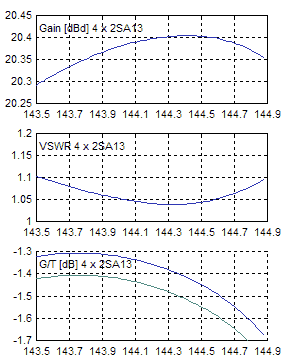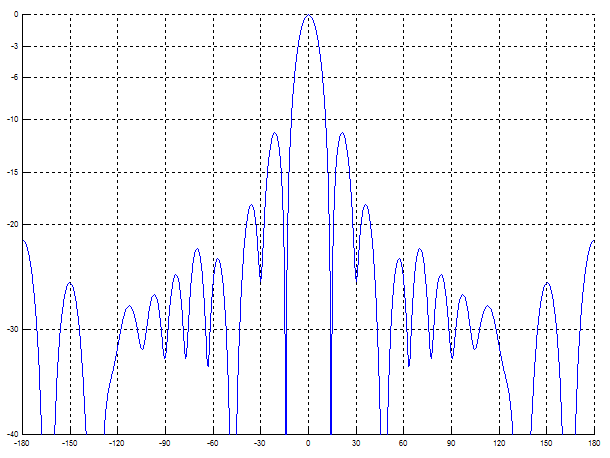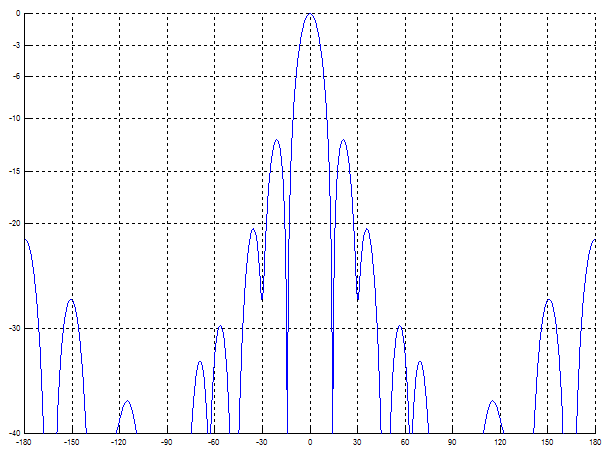The original design of 2SA13 has 10/8 mm aluminium tubes for the feed element. It has turned out to be more practical to use 6 mm rods and therefore the length of the feed element has to be increased to compensate. As a second order effect the coupling to surrounding elements is changed and therefore a rerun of the optimisation is motivated although the improvements by allowing the other elements to readjust is extremely small.
Reoptimisation for 6 mm feed element.
The original design assumed the conductivity of the aluminium elements to be 27*106. The alloys used for production will be 6082-T6 for the 6 mm rods and 6063-T6 for the 10/8 mm tubes. The conductivities are 26*106 and 30*106 respectively.
Since the changes are very small with respect to the original optimisation, no control parameters were changed, OMNEC was just allowed to find a new optimum with the same control parameters. The element positions were rounded to one mm and after that the element lengths were allowed to readjust, a procedure that does not change the antenna properties at all in the NEC2 simulation. Table 1 shows the final dimensions of 2SA13 for OMNEC with 19 segments per element. The NEC2 input file of the four-stack used for optimisation can be downloaded here: INPUT.NEC
Table 1Dimensions of the 2SA13 with 6 mm diameter for the radiator. The change with respect to the original design is given within parenthesis. This table shows the dimensions to use with the modified NEC2 model of OMNEC | |||||||||||||||||
|
The 2SA13 physical dimensions in free space From studies of the impedance vs frequency for an antenna with accurately known physical dimensions we know that 6 mm rods should be made about 2.03 mm shorter than the NEC2(mod) lengths while 10/8 mm tubes should be made about 0.08 mm longer. Table 2 shows the real world free space element lengths for the 2SA13. | |||||||||||||||
Table 1Dimensions of the 2SA13 in free space. | |||||||||||||
|
VSWR, pattern and gain in free space Figure 1 shows VSWR, G and G/T for a four-stack of the 2 SA13. These plots are generated from the data in result_eplane.nec and result_hplane.nec | |||||||||||

Figure 1 Gain, VSWR and G/T for a four-stack of 2SA13. | |||||||||
|
G/T differs between vertical and horisontal polarisation by about 0.1 dB for all frequencies. The performance data on 144.1 MHz for a four-stack of the 2SA13 at a stacking distance of 4.2 meters is like this (according to NEC2): Gain 20.40 dBd Half Power Beam Width 13o (E and H planes) F/B 21.4 dB G/T -1.44 dB horizontal, -1.34 dB vertical. Figure 2 shows the H pattern and figure 3 shows the E pattern of a four-stack of the 2SA13. These figures are generated from the data in patt_eplane.nec and patt_hplane.nec | |||||||

Fig. 2. The H-pattern of a four-stack of 2SA13 at 144.1 MHz. | |||||
|
| |||

Fig. 3. The E-pattern of a four-stack of 2SA13 at 144.1 MHz. | |
|
This file contains the full pattern in azimuth and elevation: pattern_3d.nec This file shows the amount of power that is radiated within an angle w from the forward direction: powinteg.nec The data shows that 69% of the power is radiated within 10o from the forward direction while 23% of the power is radiated outside 14o, the angle of the dip between the main lobe and the first sidelobe that originates in the stacking at 4.2 meters. |